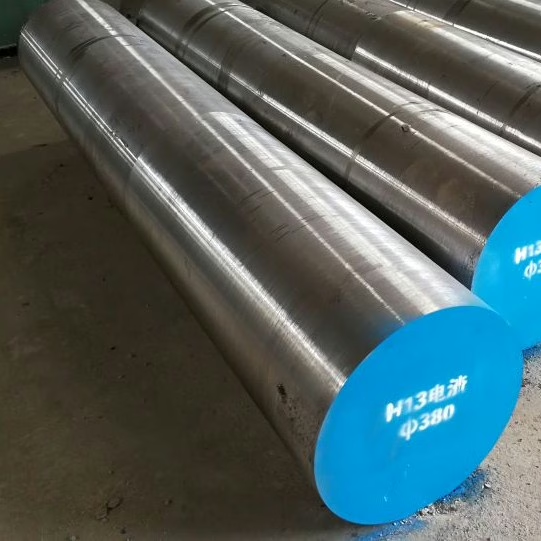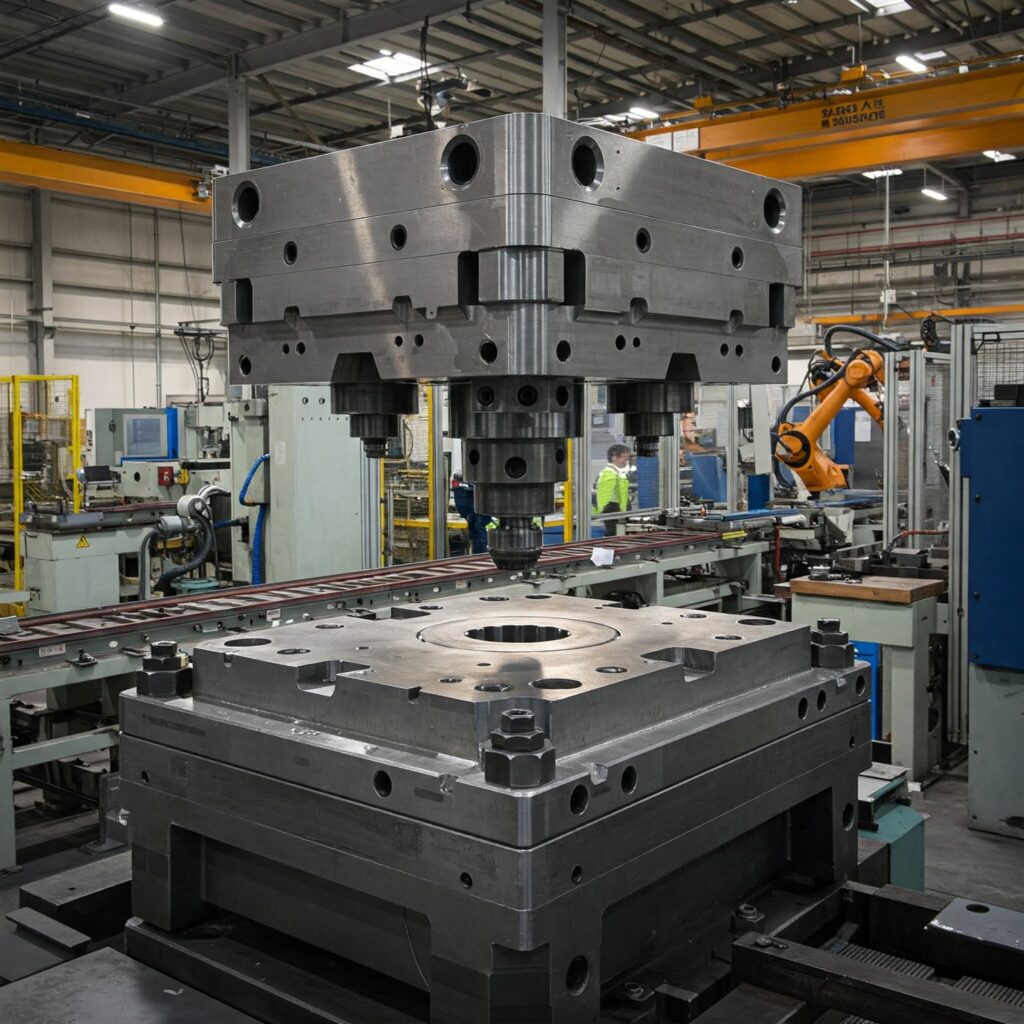Odhadovaná doba čtení: 7 minut
Klíčové poznatky
- H13 tool steel is known for its toughness, heat resistance, and wear resistance, making it ideal for high-temperature mold applications.
- It has a unique composition with 5% chromium and performs well under high mechanical loads, commonly used in die casting and hot forging.
- When comparing H13 and H11, H13 offers superior wear resistance but less toughness due to higher vanadium content.
- H13 distinguishes itself from A2 tool steel, which is better for cold work applications, as H13 excels in high-temperature environments.
- In modern tooling, H13 represents an optimal balance between heat, pressure, and wear resistance, ensuring extended service life.
Obsah
Nástrojová ocel H13 is globally recognized as the “workhorse” for high-temperature mold applications. As a classic 5% chromium-based hot-work tool steel, its defining characteristic lies in its balanced performance across the three core metrics of toughness, heat resistance, and wear resistance.
H13 excels in demanding environments requiring repeated exposure to high-temperature shocks and significant mechanical loads. It is frequently employed in die casting molds, hot extrusion, and hot forging processes.
To ensure precise material selection in actual production, we must not only understand H13 itself but also its equivalent grades under international standards. Comparing its performance against other mainstream tool steels and alloy steels enables decisions that best meet engineering requirements.
The Identity of H13 Tool Steel
H13 is classified as a “5% chromium” hot-work steel due to its chemical composition. Its typical composition ranges (by weight) are as follows: Carbon (C): 0.32% – 0.45%; Chromium (Cr): 4.75% – 5.50%; Molybdenum (Mo): 1.10% – 1.25%; Manganese (Mn): 0.50% – 0.60%; Silicon (Si): 0.10% – 0.20%; Phosphorus (P): ≤0.05%; Sulfur ( (C): 0.32% – 0.45%; Chromium (Cr): 4.75% – 5.50%; Molybdenum (Mo): 1.10% – 1.75%; Vanadium (V): 0.80% – 1.20%
H13 belongs to the H series in the AISI(American Iron and Steel Institute) system. The letter H denotes hot-work tool steel, whose material properties primarily focus on stability and high strength at elevated temperatures.
The AISI (American Iron and Steel Institute) designation H13 tool steel has well-established counterparts across various international standardization bodies.
| Norma | Designation/Symbol | Material Number | UNS Number |
| AISI/SAE/ASTM | H13 | – | T20813 |
| EN/DIN/ISO | X40CrMoV5-1 | 1.2344 | – |
| JIS G 4404 | SKD 61 | – | – |
The most common European designation and the answer to the 1.2344 steel equivalent query is the DIN/EN material number 1.2344. This material is chemically designated as X40CrMoV5-1 according to ISO 4957:1999.

H13 vs H11 (1.2343 Steel Equivalent) Comparison
In discussions about selecting mold steel, H13 is often compared to its “twin brother,” Nástrojová ocel H11 (1.2343 Steel Equivalent).
Although both belong to the 5% chromium hot-work tool steel series and share highly similar chemical compositions, heat treatment processes, and fundamental properties, they have distinct application focuses.
The core distinction between H13 and H11 lies in the content of the alloying element vanadium. H13 is a steel grade derived from H11 by increasing the vanadium content.
Due to this difference in vanadium content, their performance characteristics exhibit a “trade-off” relationship.
The higher vanadium content in H13 promotes the formation of more uniformly dispersed, hard vanadium carbides. These carbides significantly enhance the material’s wear resistance. Additionally, H13 exhibits slightly better tempering resistance, making it less prone to softening at elevated temperatures and offering superior thermal stability.
While pursuing high wear resistance, H13 exhibits slightly reduced toughness compared to H11. Although H11’s inherent toughness is not exceptionally high relative to structural steels, within the tool steel category, H11 often represents a safer choice if your mold primarily faces severe impact loads rather than wear.
Regarding hardenability, while H13 offers excellent deep hardenability suitable for large molds, H11 demonstrates slightly superior hardenability in certain comparative tests.
H13 (1.2344) is essentially an “enhanced version” of H11 (1.2343), sacrificing a small amount of toughness for superior wear resistance and high-temperature stability.
H13 vs A2 Tool Steel Comparison
Comparing across steel categories, H13 (hot-work tool steel) and Nástrojová ocel A2 (cold-work tool steel) were designed for fundamentally different purposes. Yet in certain critical applications, users often find themselves torn between the two. We’ve summarized the core differences between these materials in terms of wear resistance, toughness, and machinability. H13 (hot work tool steel) is specifically designed for high-temperature environments. Its strength lies in maintaining excellent toughness and resistance to thermal cracking regardless of temperature. A2 (cold work tool steel): This is a versatile air-hardening steel. It serves as the “gold standard” for cold work applications, offering outstanding wear resistance and dimensional stability after heat treatment.
The relative values of key properties, where 9 is best, 1 is worst, for comparison:
| Ocel | Klasifikace | Odolnost proti opotřebení | Houževnatost | Tvrdost za horka | Hardness (Typical HRC) |
| H13 | Hot Work (H) | 3 (Medium) | 9 (Very high) | 6 (High) | 45–50 HRC |
| A2 | Cold Work (A) | 6 (High) | 5 (Medium) | 5 (High) | 57–62 HRC |
If your mold operates at elevated temperatures, such as in die casting or hot forging, or faces significant impact risks that could cause fracturing, we strongly recommend selecting H13. If your mold operates at ambient temperatures and the primary failure mode is wear, such as in thin-sheet stamping or paper cutting blades, we consider A2 to be the more standard choice.
H13 Steel vs 4140 Comparison
AISI 4140 is a medium alloy carbon steel used for moderately severe service conditions where moderate hardenability, good strength, and toughness are required34. While popular in toolrooms, it is not classified as a tool steel.
While H13 is specifically formulated for thermal stability and hot wear resistance, 4140 is a more general-purpose material. In hot forging operations, 4140 is sometimes utilized for non-critical parts like backup blocks or shrink rings. However, for demanding hot-work components, such as die inserts or punches, that require exceptional toughness, abrasion resistance, and resistance to heat cracking, H13 is the recommended choice.
| Funkce | H13 Tool Steel (T20813) | 4140 Alloy Steel (G41400) |
| Klasifikace | Nástrojová ocel pro práci za tepla | Medium Alloy Structural Steel |
| Primary Strength | Ultrahigh-strength (Yields > 200 ksi) | Ultrahigh-strength (Yields often up to ~180 ksi) |
| Typical Use | Die casting, hot forging dies, plastic molds | Machine parts, tooling applications (often supplied prehardened) |
| Machinability (Annealed) | 75 (Compared to W1 at 100) | 85 (Compared to W1 at 100) |
| Nitridace | Provides high core strength with high case hardness (>1000 HV), excellent for impact/high unit loading | Core hardness affects case hardness (e.g., 21–37 HRC core) |
All core components that directly contact high-temperature metals, endure severe thermal cycling, and require resistance to heat cracking and high wear resistance (such as mold cores, punches, and hot forging dies) must use H13. 4140 cannot withstand such thermal loads and will fail rapidly. For non-critical components like mold bases, backup blocks, or shrink rings, using expensive H13 is a significant waste. 4140 offers good toughness and lower cost, making it the ideal choice.
H13 vs S7 Tool Steel Comparison
Nástrojová ocel S7 is characterized as a shock-resisting tool steel (S-type classification). Both have low carbon content and excellent toughness. S7 boasts extremely high impact resistance and excels at withstanding sudden heavy loads without fracturing. It is commonly used for cold-working shear blades, chisels, and certain medium-temperature hot-working dies.
| Property (Relative Rating 1-9) | H13 | S7 |
| Odolnost proti opotřebení | 3 (Medium) | 4 (Medium) |
| Houževnatost | 9(Very High) | 8(Excellent) |
| Tvrdost za horka | 6(High) | 5(Generally Low for S-types) |
| Machinability (Annealed) | 7(good) | 7(good) |
If your tool primarily faces violent impacts or shear forces at room temperature (such as punch breakage), select S7. If your tool requires contact with red-hot metal, choose H13 without hesitation.
Conclusion: H13’s Role in Modern Tooling
Choosing H13 essentially means choosing extended service life in harsh thermal environments. For the modern hot metal processing industry, H13 represents the optimal balance achievable between high temperatures, high pressures, and wear resistance.


